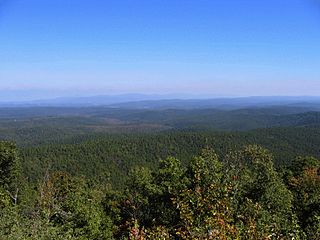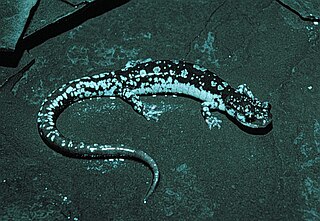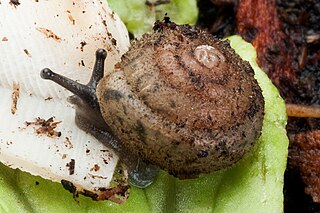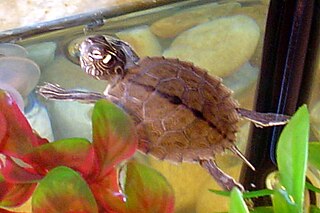
The Ouachita National Forest is a vast congressionally-designated National Forest that lies in the western portion of Arkansas and portions of extreme-eastern Oklahoma, USA.

The Boston Mountains is a Level III ecoregion designated by the Environmental Protection Agency (EPA) in the U.S. states of Arkansas and Oklahoma. Part of the Ozarks, the Boston Mountains are a deeply dissected plateau. The ecoregion is steeper than the adjacent Springfield Plateau to the north, and bordered on the south by the Arkansas Valley. The Oklahoma portion of the range is locally referred to as the Cookson Hills. There are several theories of how the mountains were named, though apparently none are related to the Massachusetts city.

The Ouachita Mountains, simply referred to as the Ouachitas, are a mountain range in western Arkansas and southeastern Oklahoma. They are formed by a thick succession of highly deformed Paleozoic strata constituting the Ouachita Fold and Thrust Belt, one of the important orogenic belts of North America. The Ouachitas continue in the subsurface to the northeast, where they make a poorly understood connection with the Appalachians and to the southwest, where they join with the Marathon uplift area of West Texas. Together with the Ozark Plateaus, the Ouachitas form the U.S. Interior Highlands. The highest natural point is Mount Magazine at 2,753 feet (839 m).

Novaculite, also called Arkansas Stone, is a microcrystalline to cryptocrystalline rock type that consists of silica in the form of chert or flint. It is commonly white to grey or black in color, with a specific gravity that ranges from 2.2 to 2.5. It is used in the production of sharpening stones. It occurs in parts of Arkansas, Oklahoma, and Texas, as well as in Japan and parts of the Middle East. The name novaculite is derived from the Latin word novacula, meaning a sharp knife, dagger, or razor, in reference to its use in sharpening. The first recorded use of the term whetstone was in reference to a honing stone from Arkansas.

The Ouachita dusky salamander is a species of salamander in the family Plethodontidae. It is endemic to the states of Arkansas and Oklahoma in the United States. The specific epithet is in honor of Herbert Hutchinson Brimley and his younger brother, Clement Samuel Brimley, both of whom were zoologists.

The Fourche Mountain salamander is a species of salamander in the family Plethodontidae endemic to the Ouachita Mountains in the central United States. Its natural habitat is temperate forests and it is threatened by habitat loss.

The Rich Mountain salamander is a species of salamander in the family Plethodontidae. It is endemic to the Ouachita Mountains in western Arkansas and eastern Oklahoma. Its natural habitat is temperate forests. It is threatened by habitat loss.
The Caddo madtom is a species of fish in the family Ictaluridae endemic to the United States. N. taylori was named in honor of William Ralph Taylor, U.S. National Museum, in recognition of his contributions to the knowledge of catfishes. They average 2 to 4 inches long and weigh no more than a few ounces. N. taylori has a small to tiny, fragmented range, but is mostly found in the Caddo, Ouachita, and Little Missouri Rivers in southwestern Arkansas. Ecological studies indicate that dam and bridge construction poses barriers to dispersal and migration of fish in the Ouachita Highlands. IUCNredlist.org states that better information is needed on life history, reproductive biology, and ecology of the Caddo madtom. This species is listed as endangered on the IUCN Red List. Limited range makes this species vulnerable to habitat destruction/degradation from impoundment, pollution, and other factors. Robison and Buchanan (1988) stated, "this rare species should be considered threatened due to loss of habitat". Warren et al. (2000) categorized the species as "threatened".
†Carelia pilsbryi was a species of small, air-breathing, land snail, terrestrial pulmonate gastropod mollusc in the family Amastridae.

The winged mapleleaf, also known as false mapleleaf, or hickory nut shell, and with the scientific name Quadrula fragosa, is a species of freshwater mussel. It is an aquatic bivalve mollusk in the family Unionidae, the river mussels. It is endemic to the United States.
Stenotrema hubrichti is a species of air-breathing land snail, a terrestrial pulmonate gastropod mollusc in the family Polygyridae. This species is endemic to the United States.

Stenotrema is a genus of air-breathing land snails, terrestrial pulmonate gastropod molluscs in the family Polygyridae. These are typically small to medium-sized snails, with a velvety or hairy shell surface, and a narrow aperture which is usually closely guarded by well-developed "teeth".

Euchemotrema is a genus of small, air-breathing land snails, terrestrial pulmonate gastropod molluscs in the family Polygyridae.

The Kiamichi Mountains are a mountain range in southeastern Oklahoma. A subrange within the larger Ouachita Mountains that extend from Oklahoma to western Arkansas, the Kiamichi Mountains sit within Le Flore, Pushmataha and McCurtain counties near the towns of Poteau, Albion and Smithville. The foothills of the Kiamichi Mountains sit within Haskell County, Northern Latimer County and Northern Pittsburg County. Its peaks, which line up south of the Kiamichi River, reach 2,500 feet in elevation. The range was the namesake of Kiamichi Country, the official tourism designation for southeastern Oklahoma, until the designation was changed to Choctaw Country.

Stenotrema florida, common name the Apalachicola slitmouth, is a species of air-breathing land snail, a terrestrial pulmonate gastropod mollusc in the family Polygyridae.

The Ouachita map turtle is a species of turtle belonging to the family Emydidae.

Stenotrema hirsutum, common name hairy slitmouth, is a species of air-breathing land snail, a terrestrial pulmonate gastropod mollusc in the family Polygyridae.
The Caney Creek Wilderness is a rugged 14,460-acre (58.5 km2) segment of the Ouachita National Forest near the mountain town of Mena, Arkansas. It was designated by Congress in 1975 as the first wilderness area in Arkansas. The wilderness' main drainage and namesake, Caney Creek, winds through old-growth bottomland forest and is surrounded by tall, steep ridges, with the clear Cossatot River bordering the wilderness on the west side. The wilderness is known for exceptional air and water quality as well as virgin forest and excellent vistas.

Spiranthes niklasii, also known by the common name Niklas' ladies' tresses, is a terrestrial orchid nearly endemic to the Ouachita Mountains in Arkansas and Oklahoma with a few other known populations.
Stenotrema calvescens, common name Chattanooga slitmouth, is a species of air-breathing land snail, a terrestrial pulmonate gastropod mollusc in the subfamily Triodopsinae of the family Polygyridae.














